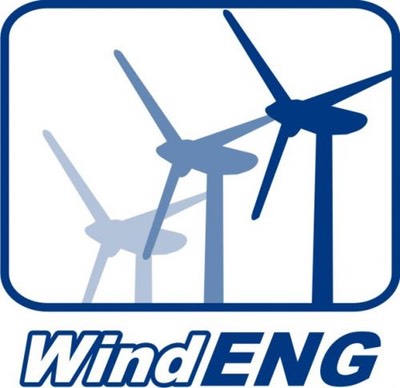(Note: These are the rules for the 2014 competition. The rules for other years were different.)
Scoring
The total performance score will consist of 50% average power (in Watts) and 50% power density (in Watts/kg) as calculated below:
Power Score = 25 * [ log10(Power * I ) + 2 ] / 3.5
Power Density Score = 25 * [log10(Power Density * I ) + 2 ] / 3.5
TOTAL PERFORMANCE SCORE = POWER SCORE + POWER DENSITY SCORE
No negative scores will be assigned.
I
is an Innovation multiplier decided as follows:
I = 1.0 for all conventionally bladed horizontal turbines with 2 or more blades
I = 10.0 for all other turbines
Judges will assign the appropriate value of the innovation multiplier.
NOTE: The no 3 blade horizontal turbine rule is now extended to no 3-7 bladed horizontal turbines allowed.
Entries from the same school must prove to be distinctly different. Distinctly different requires different support structure, different gearing approach AND different wind collection concept.
The intent of these rules changes is to stimulate and reward alternative designs through the innovation multiplier and through the elimination of 3-7 bladed horizontal turbines. The use of the log scale will effectively increase the importance of the judging and video components of the competition.
Teams
Every high school (public or private) in Ontario is eligible to enter a team for the competition.
A maximum number of 2 teams can be sent from any individual school. Preference will be given to the schools in the order of date registered.
There are no restrictions on the number of members making up a team but there must be a minimum of 2 students per team.
There must be a Teacher/Parent Advisor for each team. It is the responsibility of this person to enter and manage the students, however, only the students are required to attend on the day of competition. Please note that we will not be responsible for supervision of the students.
In order to be considered for the competition all members of your team must be present on the competition day unless your school is farther than 399km (as described by Google Maps, e.g. directions from Guelph Ontario to Sudbury Ontario = 443km), in this case you can submit your windmill by mail (at your own cost). You must include assembly instructions if applicable and your submission must arrive to the University of Guelph’s School of Engineering before the competition day.
Turbine
The windmill blades must not be constructed from metal.
You must use the provided DC motor as the sole power generator for your windmill.
The DC motor must be easily removable from your windmill for the purpose of inspection.
You can attach whatever you want to the motor (eg. gears, bearing, supports etc.).
The windmills must be homemade (eg. you cannot use fan blades) and not a pre-packaged windmill kit available from retail companies.
Wind Tunnel
Only registered student competitors will be able to enter the wind tunnel competition area. Teacher or parent advisors will be able to watch and provide verbal support if they wish to do so.
Your windmill design must be less than 0.9m wide, 0.5m deep and 0.9m high. It also must be able to operate within the 4 foot internal dimensions of the tunnel.


Make sure your design will be able to fit through the wind tunnel side entrance and is able to operate within the wind tunnel before competition day. It is highly recommended to make your design fit easily within these dimensions.
You will have 3 minutes maximum to setup. During this period, you can test and adjust your turbine with the fan on.
There is a 7/16 inch -14 UNC diameter bolt and nut protruding from the floor of the wind tunnel for the purpose of securing your windmill to the tunnel.



Make sure there are wire connections accessible from your motor that we can attach our own 10 watt 10 ohm resistor in the circuit on competition day (this is a different resistor than the "practice" 2% 1 watt 10 ohm resistor included in the resource package we send you).

Power must be generated solely by the wind from the wind tunnel once testing commences.
In order to receive full marks for windmill functionality your windmill design must be able to start once the wind tunnel is activated with no external assistance (a 10% deduction will be applied to teams that require a "kick start" to get their windmill going).
Once the setup period is complete, the wind tunnel will be turned on. The wind speed will be brought up to 5.0m/s. Once the wind tunnel is up to speed, the timer will be started. Average power is over a testing period of 60 seconds.
If your windmill slips, breaks apart, or falls over after the 3 minute setup time period you will not be granted another opportunity to setup during that heat. Teams that were not able to run their windmill for the competition will be invited to compete in the Consolation Heat - this automatically eliminates you from competing in the final heat. Make sure to thoroughly test your windmill before attending the competition, wind at 5 m/s through the wind tunnel is surprisingly powerful.
If your windmill design restricts the airflow through the wind tunnel to such a level that the testing speed cannot be achieved when the variable controller for the wind tunnel is set 5% beyond the "no load" preset level (the tunnel operating at 5m/s with no obstruction eg. a windmill in it), the controller will be set to this 5% level for the testing period.
In the event of a tie in overall score, the winning team will be decided as the team with the highest average power output.
